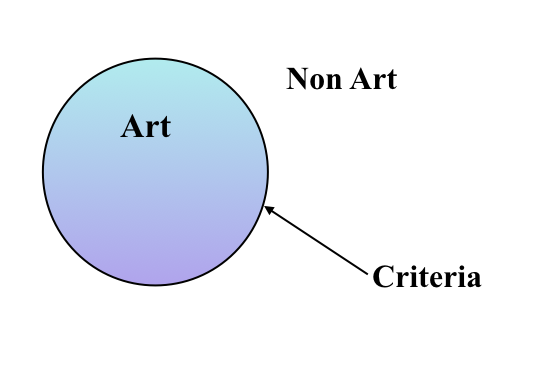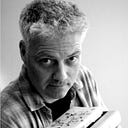Distinguishing Art from Non Art: Discussion 2, Part 1
Morris Weitz and Prior Theories of Art
In this discussion I’m turning the light upon Morris Weitz a philosopher who lived from 1916 to 1981. His areas of expertise were aesthetics and ontology. Aesthetics is concerned with the nature of art and the criteria of artistic judgement. Ontology deals with the nature of being. Weitz has been described as undertaking the task of “elucidating both ordinary and technical concepts,” and of “conceptual analysis.”
Our focus will be one of his most influential papers, The Role of Theory in Aesthetics (1956), which advocated what we may call an open definition of art.
Basically, Weitz examined the question, what are the criteria that guarantee a thing of the world is art versus non art? In his view, this was a faulty question. The answer would never be forthcoming, or if there were an answer, it would be illegitimate. We will unpack this carefully.
Let us think of a circle. Inside the circle are all things in the world that are art. Outside the circle are all things that are not art.

The boundary of the circle then is formed by the criteria that function as guarantees. If a thing fits the criteria it is inside the circle and is art. If it doesn’t pass the criteria it remains outside the circle and is not art.
Throughout history there have been attempts to establish criteria that would guarantee a thing was art versus not art and Weitz looked at each in his article. We’ll briefly go over them as we find they are still at issue in many discussions about art.
Expressionists: In our last discussion we saw how the Expressionists like Collingwood believed the purpose of art, indeed a necessary condition that made something art, was the expression of human emotion and this is very closely related to Emotionalists.
Emotionalists: In their view too one of the main functions of art is to express, evoke, or reflect back emotion, from creator to self or creator to others. We include the writer Leo Tolstoy and philosopher John Curt Ducasse in this group. Tolstoy wrote, “By words one transmits thoughts to another; by means of art, one transmits feelings.” Tolstoy was no common artist but his thoughts here align with a common and plebeian understanding of the function of art.
If you ask most people who have no university level art education what differentiates art from non-art they’ll frequently answer something along the lines of, “Art makes me feel emotion.” They might argue that a Monet painting or an electronic dance music concert evokes emotion while a pencil does not. When challenged, Emotionalists may admit they also feel strong emotions when smelling something rotten, so they clarify and say art makes them feel a pleasing or beautiful emotion. This obviously becomes problematic for them. Emotionalists also get stymied by the fact that not everyone feels the same emotion about or from work of art.

Formalists: For Formalists, art must have plastic elements in relation to each other. Plastic elements are aspects one can modify. These include colors, line differences, shapes, scale, and so forth. The artist manipulates these plastic elements so they work together to create significant form, and thus the thing is art. Viewers then expected to respond strongly to the aesthetics of this masterly combination. Plastic elements working together is one aspect of creating that art schools typically spend a good deal of time on courses. Art critics Clive Bell and Roger Fry fall into the Formalist camp. Formalists often presuppose that a work of art must have specific elements, such as line width differences or color repetition. As well, they often presuppose ways the parts should come together using certain rules of composition. They get stymied when art doesn’t have these elements or when art doesn’t follow their set of rules.
Organicists: This is a variation of Formalist thought. The Organicists focus on parts coming together in a complex interrelationship to form an organic whole. One way to think about this is to say 1+1=3. This is meant to show that the sum of the parts is greater than simply adding together the individual parts. The fancy word for those interested is mereology: the theory of relations of parts to whole and part to part within the whole. Organicists presuppose there is a way to tell what unity or wholeness is. They often use Formalist criteria to justify the way part should work together. They get stymied by works of art that do not fit their idea of an organic whole.
It’s worth pausing for a moment to remind ourselves of the fact that art may be looked at, or analyzed, with a lens of any of these theories. We may look at the way an artist expresses emotion, or we might consider we feel when we look at a work of art, or we might discuss the formal aspects and whether we think the work has what’s called unity. However, what we have to remember is that we are looking at rules that guarantee a thing of the world is a work of art versus a things of the world that is not art. A lens by which we examine art is different than a guarantee that something is art. Ok let’s continue.
Intuitionists: The intuitionists think that neither the expression of emotion nor plastic elements working together is what makes art. Philosopher, statesman, and historian Benedetto Croce, for example, said art arose from a specific creative, cognitive, or spiritual act. Art is the process of bringing personal images and intuitions into lyrical clarification and expression. The awareness, the intuition, exists below the level of conceptualization. We don’t think about it. This also is a strong belief when it comes to valuing work. People believe they just know it’s great without being able to tell why. Intuitionists are often stymied by work that is minimal, or which they perceive as lacking emotion, or which seems clearly bad.
Voluntarists: Dewitt Henry Parker primarily is known as a Voluntarist. He wanted a complex definition and thus suggested art was three things: the embodiment of wishes and desires imaginatively presented so that the artist’s goal was captured, language (one could share art and ideas about art creation this way), and harmony that layers the imaginative. Art could be created, talked about, and it possessed harmony. In these, art had superior unity, as opposed to simply a found or mechanical arrangement. He saw a difference between the scientist’s description of a flower and the poet’s description of a flower, or between a drawing of a flower and a photograph of a flower. Voluntarists were stymied by work that didn’t appear to have harmony, that might be machine generated, dispassionate, or which couldn’t be shared.

Weitz declared that any and all of these theories were inadequate for stating criteria that guaranteed a thing of the world was art. He wrote, “Each purports to be a complete statement about the defining feature of all works of art and yet each of them leaves out something which the others take to be central.” Each theory suggested criteria but none of them fit all art, some contradicted each other, and some were just too general to be useful. Other theories presupposed that a thing became art when it fit what art was, or fit what art looked like, which is known in philosophy as begging the question, or circular reasoning. This is, as we will see later on, a common problem found in many considerations of what sorts of things are and can be art versus non art.
Next, Weitz looked at the issue from the other side. Any of these criteria could be applied to things considered non-art. We might look at pets, a loaf of bread, a rock, the sky and find they meet the criteria. A kitten can generate emotion in a person. A rock can be seen to have harmony. A blender can be analyzed in terms of its formal elements.
Weitz advocated not for a closed definition of art, with necessary and sufficient conditions, but an open definition. However it was later said to be too broad. A definition that includes everything is not a definition. Did Weitz paint himself into a corner? What was his answer? We’ll look at his way out in part 2 of this discussion.
